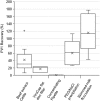Evaluation of Secondary Concentration Methods for Poliovirus Detection in Wastewater
- PMID: 30612304
- PMCID: PMC6394643
- DOI: 10.1007/s12560-018-09364-y
Evaluation of Secondary Concentration Methods for Poliovirus Detection in Wastewater
Abstract
Effective surveillance of human enteric viruses is critical to estimate disease prevalence within a community and can be a vital supplement to clinical surveillance. This study sought to evaluate simple, effective, and inexpensive secondary concentration methods for use with ViroCap™ filter eluate for environmental surveillance of poliovirus. Wastewater was primary concentrated using cartridge ViroCap filters, seeded with poliovirus type 1 (PV1), and then concentrated using five secondary concentration methods (beef extract-Celite, ViroCap flat disc filter, InnovaPrep® Concentrating Pipette, polyethylene glycol [PEG]/sodium chloride [NaCl] precipitation, and skimmed-milk flocculation). PV1 was enumerated in secondary concentrates by plaque assay on BGMK cells. Of the five tested methods, PEG/NaCl precipitation and skimmed-milk flocculation resulted in the highest PV1 recoveries. Optimization of the skimmed-milk flocculation method resulted in a greater PV1 recovery (106 ± 24.8%) when compared to PEG/NaCl precipitation (59.5 ± 19.4%) (p = 0.004, t-test). The high PV1 recovery, short processing time, low reagent cost, no required refrigeration, and requirement for only standard laboratory equipment suggest that the skimmed-milk flocculation method would be a good candidate to be field-validated for secondary concentration of environmental ViroCap filter samples containing poliovirus.
Keywords: Enteric viruses; Environmental surveillance; Poliovirus; Skimmed-milk flocculation; Wastewater.
Conflict of interest statement
Conflict of interest
The authors declare that they have not conflict of interest.
Research Involving Human Participants and/or Animals
This article does not contain any studies with human participants or animals performed by any of the authors.
Informed Consent
Informed consent was not required, as no human participants or individuals were included in this study.
Figures


References
-
- Aw TG, Gin KY, -H Environmental surveillance and molecular characterization of human enteric viruses in tropical urban wastewaters. Journal of Applied Microbiology. 2010;109:716–730. - PubMed
-
- Blacklow NR, Greenberg HB. Viral gastroenteritis. The New England Journal of Medicine. 1991;325:252–264. - PubMed
-
- Calgua B, Fumian T, Rusiñol M, et al. Detection and quantification of classic and emerging viruses by skimmed-milk flocculation and PCR in river water from two geographical areas. Water Research. 2013;47:2797. - PubMed
Publication types
MeSH terms
Substances
Grants and funding
LinkOut - more resources
Full Text Sources

